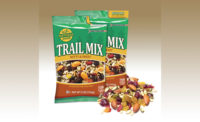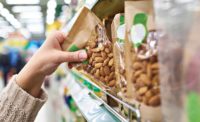The latest advances in convenience packaging options—single-serve, re-sealable, portion-controlled, on-the-go—offer retailers and consumers greater convenience, reliable containment, and sustained freshness. Increased recyclability and sustainability are other features. This is good news for bakery and snack producers who are striving to meet consumer demand.
In addition to meeting major brands’ recyclability and sustainability goals in convenience packaging materials, vendors also must adapt to new pack options that consumer are demanding. “On-the-go packaging includes portion-controlled and single-serve pack types. We continue to see new versions of these packages and machinery evolutions that keep us on our toes in developing seamless, easy-open, resealable and tamper-evident features,” says Heather Chandler, president, Sealstrip Corp., Gilbertsville, PA.
One benefit of a resealable package is product containment and reduced exposure. “Resealable features do not restore the original package barrier conditions, but they do prevent repackaging of product in the wrong type of film, bag or container, which can cause a faster degradation of taste and texture. Also, baked items can be contained in the original package to minimize exposure to oxygen, which can cause staleness and freezer burn,” Chandler adds.
On the packaging material end, the demand for ready-to-eat, convenience snack foods has prompted a recent surge in polypropylene demand. Benefits of using polypropylene include its light weight, clarity (allowing customers to see through to the product), affordability, sustainability, and resistance to high and low temperature, such as that in a microwave oven or a freezer, while maintaining freshness and durability.
“As this material satisfies many current consumer and manufacturer packaging concerns, it is expected that demand for polypropylene packaging will increase and potentially take share from polyethylene terephthalate (PET) in food packaging applications,” says Sean Riley, senior director, media and communications, PMMI, Reston, VA.
According to PMMI’s 2020 “Secondary Packaging Trends” report, as e-commerce has grown, consumers have become increasingly accustomed to the convenience of online shopping, with the largest businesses setting trends and establishing expectations of quick and trackable delivery. “As customers have come to expect rapid delivery of their products, many retailers have been pushed toward a direct-to-consumer model, shipping items directly from their own warehouses. This has put a strain on some of the smaller, more niche bakery and snack manufacturers as it leaves less opportunity for them to keep pace,” Riley adds.
The meaning of convenience is evolving, according to Michelle Sauder, senior marketing manager for Dow Packaging and Specialty Plastics, Midland, MI. “With COVID lingering, we have to think about what convenience means today. The biggest change we’ve seen is that convenience is now synonymous with e-commerce. With more categories being purchased online, companies are re-evaluating their packaging formats and how well they fit with e-commerce trends.”
Material innovations
The latest convenience packaging innovations are designed to meet the needs of on-the-go, health-conscious consumers. For example, bag closures from Kwik Lok Corp., Yakima, WA, help keep food fresh and safe and offer the consumer the option of reclosing the package so they can enjoy the rest of the product at a later date.
“However, just because consumers want grab-and-go solutions that meet with their lifestyle doesn’t mean they are willing to forgo their values on sustainability. They want products that are sustainable and keep their food safe,” says Karen K. Reed, director of marketing and communications, noting that Kwik Lok’s Eco-Lok closure is sustainable and reusable. “We also offer the 909 tamper-evident machine that uses a laser stitch across the opening, which helps consumers see if their food item has been tampered with.”
Zip-Pak, Carol Stream, IL, has introduced Safety-Lok Child-Resistant Solutions in two formats.
Safety-Lok Child-Resistant Press-to-Close zipper easily integrates into manufacturing operations. The tab mechanism used to open and access the package contents is the key. A tabbed profile provides resistance for children, yet it provides easy accessibility for older consumers who may be challenged by child-resistant packaging.
Safety-Lok Child-Resistant Slider from Zip-Pak is a one-step opening mechanism that also provides resistance for children, yet easy access for adults. A proprietary clip mechanism allows the package to be opened from any position with a light squeeze, creating a wide-mouth opening for easy access to package contents.
Zip-Pak also has introduced the Soft-Crush line of zippers. “Although all Zip-Pak zippers are recyclable, Soft-Crush zippers are engineered for Eco-friendly and heat-sensitive films and pouches. The zippers are designed to achieve high-quality seals and appearance, with lower time-and-temperature application. They improve converting efficiency while minimizing sealing gaps and distortion on heat-sensitive films and pouches,” says Erin Henry, global director of innovation and marketing.
Presto Products, a business of Reynolds Consumer Products, Appleton, WI, offers the Fresh-Lock Multiplex zipper style 8555, which has five sets of interlocking channels that help seal in freshness with a closure that consumers can hear and feel. The zipper requires no lock alignment and works well with many bakery products, including those that have granules. In addition, Multiplex is totally recyclable as a component in a polyethylene recyclable package.
Presto Products also offers the Fresh-Lock Click ’N Lock sensory zipper. It features a noticeable texture between the double zippers that can be felt as the bag closes, providing sensory feedback to ensure the package is sealed tight. “Also, the zipper makes a noise when the package is opened and securely sealed. To further improve sealing, the zipper is available with a patented sealant rib design,” says Sarah Stieby, marketing manager of Fresh-Lock Closures.
Dow Packaging and Specialty Plastics has developed SURLYN ionomers, which can be used to create easy-to-open packaging. “They help converters down-gauge to create applications that use less material, maintain performance and reduce total costs. Also, Dow’s APPEEL lidding sealant resins are pre-formulated, one-bag solutions that offer increased sealing and adhesion to a variety of substrates to keep contents fresh,” Sauder says.
New horizons
Convenience packaging innovations are being tested overseas as well, according to The Active & Intelligent Packaging Industry Association, Utrecht, the Netherlands. For example, Kellogg’s has launched limited-edition World Sight Day Coco Pops cereal boxes in the U.K. The boxes use NaviLens technology, which allows a smartphone to detect and play back information; they also feature Braille embossing, and include on-pack information in a large font size.
The technology can be used both in-store and in the home. It allows smartphones to pick up an on-pack code from up to three meters away. This alerts the phone; the shopper can then choose to have the ingredients, allergen and recycling information read aloud to them, or they can read it on their device by using accessibility tools.
A trial was recently conducted in 60 co-op stores after research by the Royal National Institute of Blind People revealed that nine in 10 blind and partially sighted people feel that information on food packaging is difficult or impossible to read. If successful, Kellogg’s hopes to adapt more of its cereal boxes to include this technology.
Also, German retailer Rewe is testing reusable trays as a way to cut down on the many single-use bowls, boxes, cups and plates that are wasted. Currently being tested at five locations in coordination with reusable experts Vytal, the reusable system consists of a plastic bowl and lid. Borrowing is controlled via a Vytal app and no deposit is required.
Shoppers first scan a Quick Response (QR) code at a dispensing station; a tray can then be removed to fill at the salad bar. Customers have 14 days to return the tray free-of-charge. A separate station is available for returns where customers scan the QR code on the tray lid to open the return station door. The device checks whether the tray has been returned empty and with the lid intact. The customer receives a return confirmation via the app.
“Convenience is very high on the agenda for many consumers today. But that can mean different things to different consumers, particularly during the current pandemic. Single-serve and portion-control packs are now seen as safe and hygienic as well as minimizing waste. On-the-go is perhaps less important as many people are not going anywhere,” says Andrew Manly, AIPIA communications director.
“Resealable packaging is always popular. However, I believe its attributes are overhyped as the food, once opened, deteriorates at the same rate unsealed packs do. Better to incorporate a condition monitor, too. Smart packaging can add real value in all these areas, as well as offer routes to better recycling and reuse. It is a very convenient option on a number of levels.”
Looking ahead, concerns about food safety are going to continue, according to Reed, who says Kwik Lok is working on convenience packaging solutions that strike a balance between health and safety needs with sustainability. “We’ve made a good start by offering the Eco-Lok and the 909 but we aren’t stopping with these solutions. We will to continue working on materials and engineering innovations to help strike that balance.”




